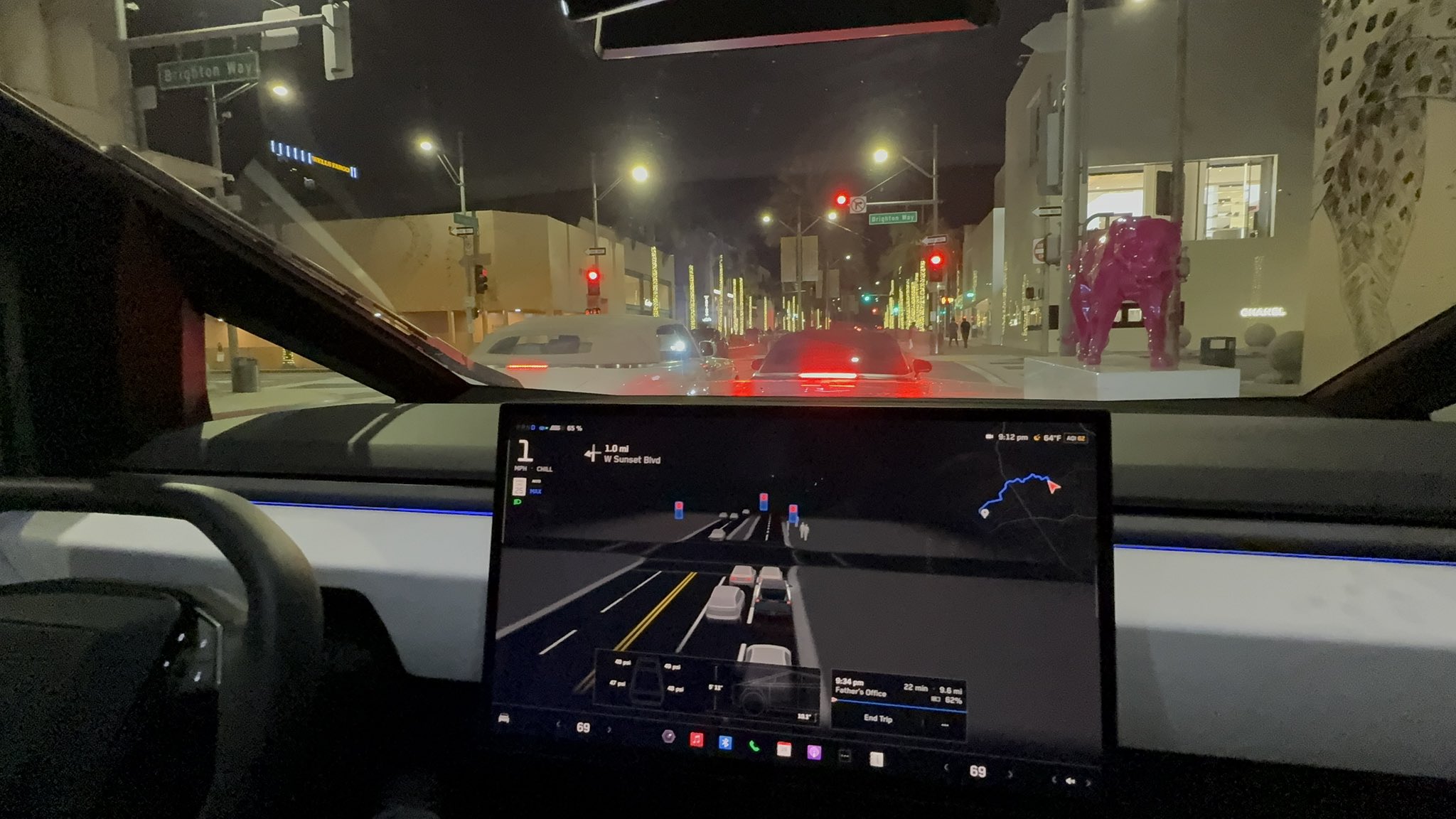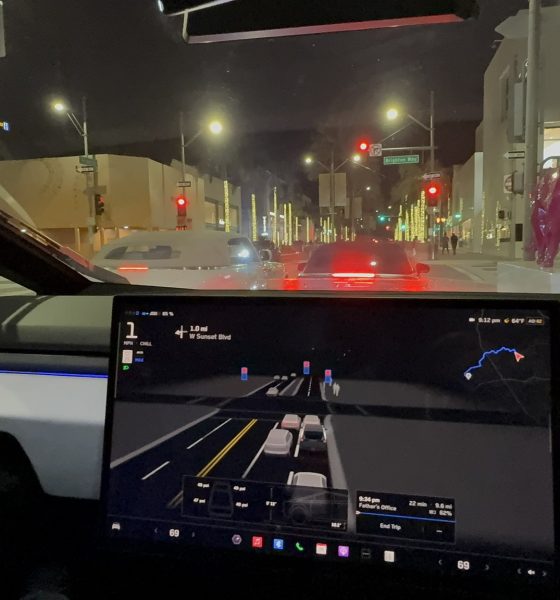The Tesla AI team successfully rolled out FSD (Supervised) for the Cybertruck this weekend. While the system has mostly been released to company employees and early access testers, the first videos of FSD (Supervised) V12.5.5 on the Cybertruck are starting to get shared online. Based on comments from Cybertruck owners so far, it would appear that FSD (Supervised) is working fairly well on the all-electric pickup truck.
Tesla Director of Autopilot Software Ashok Elluswamy noted in a post on social media platform X that the Cybertruck is the first Tesla to receive end-to-end highway driving. Release notes shared online also revealed that the Cybertruck’s FSD came with vision-based attention monitoring with sunglasses.
Among the Tesla community members whose Cybertrucks received the FSD (Supervised) update are longtime Full Self-Driving testers Whole Mars Catalog and Dirty Tesla, both of whom have been testing the advanced driver-assist system for years. Based on the two FSD veterans, it appears that the Cybertruck’s FSD (Supervised) system features a number of interesting characteristics.
The first early access build of Cybertruck FSD is out! I went for a drive from Beverly Hills to Santa Monica with @BLKMDL3 and @___alexys___ to see how it performs.
Watch in 4K: https://t.co/AB9zGX9y3H pic.twitter.com/Y7Rs0XpvZe— Whole Mars Catalog (@WholeMarsBlog) September 30, 2024
During a drive from Beverly Hills to Santa Monica in California, longtime FSD tester Whole Mars Catalog observed that the Cybertruck’s FSD system behaved just like FSD in Tesla’s other vehicles, though it needs more tuning for the larger size of the all-electric pickup truck. The Cybertruck owner also noted that FSD (Supervised) was able to make tight lane changes properly, but the system does not work in trailer mode yet.
Here’s my summary/review of FSD for Cybertruck tonight thanks to @WholeMarsBlog for the ride.
For the first FSD release it was great + better than we expected it to be. It did some things super well like having smooth turns and very smooth braking.
FSD seemed to know the size… pic.twitter.com/VKNiMpV5T5— Zack (@BLKMDL3) September 30, 2024
Fellow Tesla owner @BLKMDL3, who was with the longtime FSD tester during the Cybertruck FSD (Supervised) drive, observed that the visuals on the vehicle’s infotainment display were extremely smooth. He also noted that the Cybertruck’s FSD system displayed some smooth turning and breaking behaviors. The vehicle, however, reportedly moved a bit slow on the highway, and there were some quirks that needed ironing out.
Here’s the only mistake I saw FSD make so far in Cybertruck, but I did see it two separate times – making too sharp of a left turn.
Full video: https://t.co/Haw2AVVe1b pic.twitter.com/O9sZkNsHZH— Dirty Tesla (@DirtyTesLa) September 30, 2024
FSD veteran Dirty Tesla, for his part, opted to test the Cybertruck’s FSD (Supervised) system during a nighttime drive in Michigan. The Tesla owner observed that corrections using the Cybertruck’s steer-by-wire system were very natural and smooth. He also observed that the vehicle was able to stay in lane, perform lane changes, and exit the highway fairly well. The vehicle, however, did require a few interventions during the drive.
Cybertruck FSD takes a Michigan left (U-turn kinda, and yes rear wheel steering is used in FSD) pic.twitter.com/rkxVz4YZQJ— Dirty Tesla (@DirtyTesLa) September 30, 2024
Overall, the Tesla Cybertruck’s FSD (Supervised) system seems to be a pretty solid update to the all-electric pickup truck, though it is understandable that it is still only being released to early access testers. Considering how good this initial FSD (Supervised) version is on the Cybertruck, however, it would be very exciting to see just how much better the vehicle’s advanced driver-assist system could get in the coming months.
Check out Dirty Tesla’s Cybertruck FSD (Supervised) test in the video below.
Don’t hesitate to contact us with news tips. Just send a message to simon@teslarati.com to give us a heads up.

News
Tesla China delivery centers look packed as 2025 comes to a close
Needless to say, it appears that Tesla China seems intent on ending 2025 on a strong note.

Tesla’s delivery centers in China seem to be absolutely packed as the final days of 2025 wind down, with photos on social media showing delivery locations being filled wall-to-wall with vehicles waiting for their new owners.
Needless to say, it appears that Tesla China seems intent on ending 2025 on a strong note.
Full delivery center hints at year-end demand surge
A recent image from a Chinese delivery center posted by industry watcher @Tslachan on X revealed rows upon rows of freshly prepared Model Y and Model 3 units, some of which were adorned with red bows and teddy bears. Some customers also seem to be looking over their vehicles with Tesla delivery staff.
The images hint at a strong year-end push to clear inventory and deliver as many vehicles as possible. Interestingly enough, several Model Y L vehicles could be seen in the photos, hinting at the demand for the extended wheelbase-six seat variant of the best-selling all-electric crossover.
Strong demand in China
Consumer demand for the Model Y and Model 3 in China seems to be quite notable. This could be inferred from the estimated delivery dates for the Model 3 and Model Y, which have been extended to February 2026 for several variants. Apart from this, the Model Y and Model 3 also continue to rank well in China’s premium EV segment.
From January to November alone, the Model Y took China’s number one spot in the RMB 200,000-RMB 300,000 segment for electric vehicles, selling 359,463 units. The Model 3 sedan took third place, selling 172,392. This is quite impressive considering that both the Model Y and Model 3 are still priced at a premium compared to some of their rivals, such as the Xiaomi SU7 and YU7.
With delivery centers in December being quite busy, it does seem like Tesla China will end the year on a strong note once more.
News
Tesla Giga Berlin draws “red line” over IG Metall union’s 35-hour week demands
Factory manager André Thierig has drawn a “red line” against reducing Giga Berlin’s workweek to 35 hours, while highlighting that Tesla has actually increased its workers’ salaries more substantially than other carmakers in the country.

Tesla Giga Berlin has found itself in a new labor dispute in Germany, where union IG Metall is pushing for adoption of a collective agreement to boost wages and implement changes, such as a 35-hour workweek.
In a comment, Giga Berlin manager André Thierig drew a “red line” against reducing Giga Berlin’s workweek to 35 hours, while highlighting that Tesla has actually increased its workers’ salaries more substantially than other carmakers in the country.
Tesla factory manager’s “red line”
Tesla Germany is expected to hold a works council election in 2026, which André Thierig considers very important. As per the Giga Berlin plant manager, Giga Berlin’s plant expansion plans might be put on hold if the election favors the union. He also spoke against some of the changes that IG Metall is seeking to implement in the factory, like a 35-hour week, as noted in an rbb24 report.
“The discussion about a 35-hour week is a red line for me. We will not cross it,” Theirig said.
“(The election) will determine whether we can continue our successful path in the future in an independent, flexible, and unbureaucratic manner. Personally, I cannot imagine that the decision-makers in the USA will continue to push ahead with the factory expansion if the election results favor IG Metall.”
Giga Berlin’s wage increase
IG Metall district manager Jan Otto told the German news agency DPA that without a collective agreement, Tesla’s wages remain significantly below levels at other German car factories. He noted the company excuses this by referencing its lowest pay grade, but added: “The two lowest pay grades are not even used in car factories.”
In response, Tesla noted that it has raised the wages of Gigafactory Berlin’s workers more than their German competitors. Thierig noted that with a collective agreement, Giga Berlin’s workers would have seen a 2% wage increase this year. But thanks to Tesla not being unionized, Gigafactory Berlin workers were able to receive a 4% increase, as noted in a CarUp report.
“There was a wage increase of 2% this year in the current collective agreement. Because we are in a different economic situation than the industry as a whole, we were able to double the wages – by 4%. Since production started, this corresponds to a wage increase of more than 25% in less than four years,” Thierig stated.
News
Tesla is seeing a lot of momentum from young Koreans in their 20s-30s: report
From January to November, young buyers purchased over 21,000 Teslas, putting it far ahead of fellow imported rivals like BMW and Mercedes-Benz.

Tesla has captured the hearts of South Korea’s 20s-30s demographic, emerging as the group’s top-selling imported car brand in 2025. From January to November, young buyers purchased over 21,000 Teslas, putting it far ahead of fellow imported rivals like BMW and Mercedes-Benz.
Industry experts cited by The Economist attributed this “Tesla frenzy” to fandom culture, where buyers prioritize the brand over traditional car attributes, similar to snapping up the latest iPhone.
Model Y dominates among young buyers
Data from the Korea Imported Automobile Association showed that Tesla sold 21,757 vehicles to the 20s-30s demographic through November, compared to BMW’s 13,666 and Mercedes-Benz’s 6,983. The Model Y led the list overwhelmingly, with variants like the standard and Long Range models topping purchases for both young men and women.
Young men bought around 16,000 Teslas, mostly Model Y (over 15,000 units), followed by Model 3. Young women followed a similar pattern, favoring Model Y (3,888 units) and Model 3 (1,083 units). The Cybertruck saw minimal sales in this group.
The Model Y’s appeal lies in its family-friendly SUV design, 400-500 km range, quick acceleration, and spacious cargo, which is ideal for commuting and leisure. The Model 3, on the other hand, serves as an accessible entry point with lower pricing, which is valuable considering the country’s EV subsidies.
The Tesla boom
Experts described Tesla’s popularity as “fandom culture,” where young buyers embrace the brand despite criticisms from skeptics. Professor Lee Ho-geun called Tesla a “typical early adopter brand,” comparing purchases to iPhones.
Professor Kim Pil-soo noted that young people view Tesla more as a gadget than a car, and they are likely drawn by marketing, subsidies, and perceived value. They also tend to overlook news of numerous recalls, which are mostly over-the-air software updates, and controversies tied to the company.
Tesla’s position as Korea’s top import for 2025 seems secured. As noted by the publication, Tesla’s December sales figures have not been reported yet, but market analysts have suggested that Tesla has all but secured the top spot among the country’s imported cars this year.










